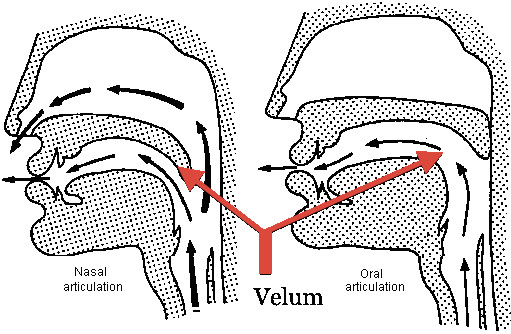Awareness | Tuning | Rounded Vowels | Nasal Vowels | English Tendencies | Consonants | Phonetic Notation Key
The French Nasal Vowels
There is one last Vowel Feature that we did not discuss - Nasalization.
- Oral Vowel - Air passes ONLY through the mouth.
- Nasal Vowel - Air passes through BOTH the mouth AND the nose.
|
If we elevate the velum only slightly to allow some air to pass through the nose AND the mouth, an extra resonation occurs in our nasal cavities, and we have what we perceive as a "nasal vowel".
Of course, we do all these things without ever thinking about it. For this reason, I have created a separate "Nasal Bootcamp" (you'll see this later) for you to focus on developing the motor skills needed to produce these sounds effortlessly. For now, you will just review the sounds and try to perceive the difference between them. |
Nasal-Oral Vowel Pairs
Just as the rounded vowels have unrounded counterparts, the nasal vowels have oral counterparts. They are listed below.
Nasal ----- Oral
ɛ̃ ----- ɛ
ɔ̃ ----- ɔ
ɑ̃ ----- ɑ*
*Note that oral /ɑ/ does not exist in standard French. The French vowel /a/ is slightly more front than /ɑ/
If you make the unrounded vowel sound /i/ and round your lips WITHOUT changing ANYTHING else in your speech organ, you will get the rounded counterpart - /y/.
Similarly, if you make the oral vowel /ɔ/ and lower your velum to allow some air to pass through your nasal passage WITHOUT changing anything else in your speech organ, you will get the nasal counterpart - /ɔ̃/.
In the audio files below, I show this by alternating between the nasal vowels and their oral counterparts. Listen and try to tune your ear to the difference. You can try to mimic the sounds yourself, but do not worry if you can't get them perfect. We will focus more on articulation later.
Similarly, if you make the oral vowel /ɔ/ and lower your velum to allow some air to pass through your nasal passage WITHOUT changing anything else in your speech organ, you will get the nasal counterpart - /ɔ̃/.
In the audio files below, I show this by alternating between the nasal vowels and their oral counterparts. Listen and try to tune your ear to the difference. You can try to mimic the sounds yourself, but do not worry if you can't get them perfect. We will focus more on articulation later.
ɛ̃ ----- ɛ
|
ɔ̃ ----- ɔ
|
ɑ̃ ----- ɑ*
|
Distinguishing the French Nasal Vowels
Because nasal vowels occur rarely in English, our ears are not sensitive to different types of nasal vowel sounds. Our brains mush them all together with the "mmm" sound.
To help you develop your French nasal vowel sensitivity, I created audio files comparing them. To bring the difference into context, I end each file with a two-syllable word that uses both vowels.
To help you develop your French nasal vowel sensitivity, I created audio files comparing them. To bring the difference into context, I end each file with a two-syllable word that uses both vowels.
ɛ̃ vs. ɑ̃ |
ɔ̃ vs. ɑ̃ |
Once again, to not get frustrated if these sound differences are not 100% obvious to you yet. Motor and perception skills take time and practice to develop. Just like everything else in this primer, you should return to this page as often as you gain more practical experience with French sounds.
Once you are comfortable with everything on this page, you may move on to English Tendencies.
Awareness | Tuning | Rounded Vowels | Nasal Vowels | English Tendencies | Consonants | Phonetic Notation Key


